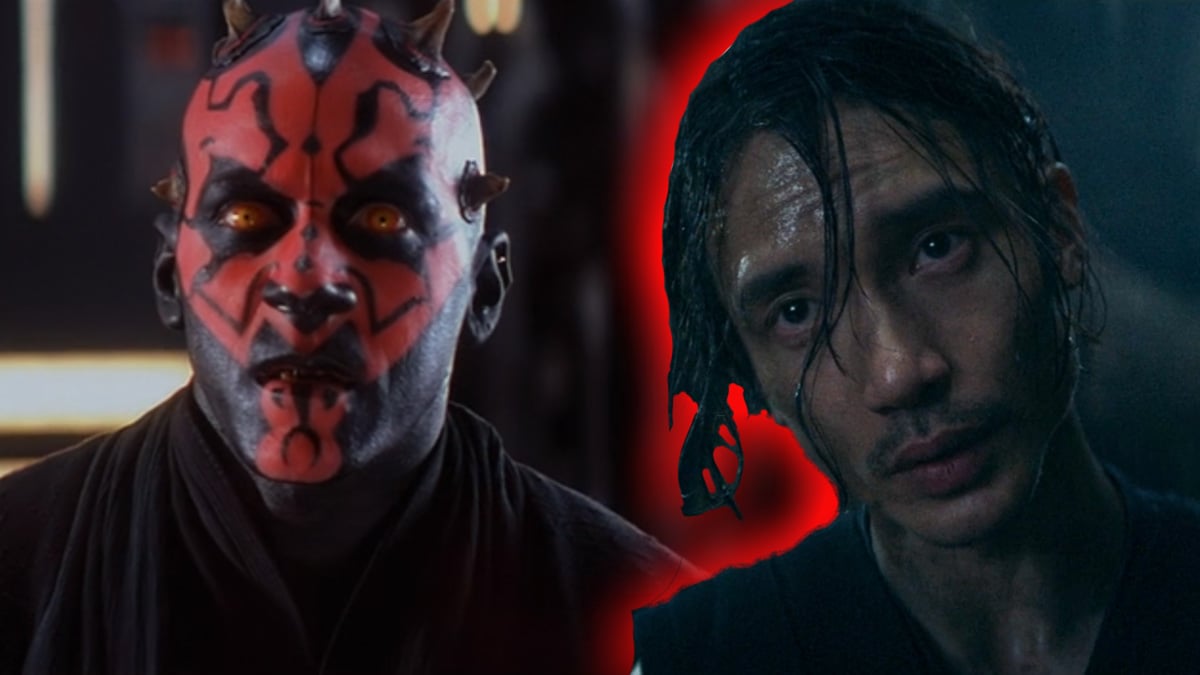Actors might make them believable, but nothing makes a character iconic like a cool design. While there are plenty of memorable designs amongst the Star Wars greats, there hasn’t been a villain as eye-catching as Darth Maul since he first graced the screen in 1999. The Sith apprentice stands apart with his multicolored skin, vicious horns, unmatched grimace, and double-ended saber.
Artist Iian McCaig was just the first step in a long process of bringing the elusive character to life. His many concept sketches have fueled the creatives behind the series since 1999, including Darth Maul’s “original face,” which was so terrifying that George Lucas had to ask the artist to tone it down.
Darth Maul’s original creepy concept sketch
The process of creating characters for films is a multi-disciplined endeavor. Teams of artist work on limited prompts to provide a wide array of sketches for directors to look through and refine. According to long time Star Wars artist, Lian McCaig, George Lucas was one of the best directors to work with.
“He doesn’t come in and tell you everything.” He said during a promo for the Denver Art Museum’s 2016 exhibit. Instead, he would give them small pieces of information to go off of. Sometimes, he would give them even less. For the iconic black and red villain, all McCaig and company got was a simple, “it’s a new Sith lord, his name is Darth Maul.”
Lucas told the artist he wanted them to brainstorm what a Sith might look like. For a film set in a real-world location, artists look through reference books of cities, fashion, and military uniforms to understand how a design should look. Star Wars can only be built around the history the films have already laid down. If there isn’t anything related in the lore, all fresh material is used.
According to StarWars.com, the original script referred to Darth Maul as “a vision from your worst nightmare.” Enlisting the help of those around them, McCaig asked his colleagues to show him their idea of what this murderous person might look like. They delivered, one posed with circuit boards on his face, another arrived with ink blotted like tattoos across his cheeks.
In the end, McCaig delivered his worst nightmare, something that will sound familiar to anyone who’s seen The Acolyte, or laid eyes on “Darth Teeth” as fans have taken to calling the series’ antagonist. He described it as, “a lifeless face with glittering dead eyes and glistening metal teeth peering at me through the rain-streaked window” Those red braids were meant to signify the water running down the specter’s face and across the glass.
The image ended up being too creepy for what Lucas intended, and freaked him out so much he couldn’t look at it for more than a few seconds. “He opened the folder, screamed, then slapped it closed and passed it back to me,” McCaig recalls, “‘Okay’, he said, ‘Give me your second worst nightmare.’”
The version the director settled on is as iconic as Jar Jar is despised – though the concept was inevitably changed by the other artists in the film’s workflow. In McCaig’s mind, all those black lines on Maul’s head were perfectly placed feathers –like some sort of ‘roided out Harpy Eagle. And that iconic grimace was just a byproduct of the wire cutting into Maul’s skin to keep them perfectly in place. It was make-up artist Nick Dudman, who interpreted the designs as horns, and created a character Ray Park would go on to breathe life into.
McCaig’s original Sith designs have shown up in The Clone Wars – Mother Talzin bears a striking resemblance to that lovely lady in the top right – and Ahsoka with the Nightsisters. The Witches of Dathomir have shown up again and again in Dave Filoni’s Star Wars projects, so it’s easy to assume that The Acolyte might be tapping into some of the old lore.
Or maybe they’re making something new. The Acolyte showrunner Leslye Headland told Starwars.com that the two workshopped the idea of Force witches who weren’t connected to the Nightsisters of Dathomir, a “not all hot tubs are a jacuzzi” sort of situation.
In the end it’s neat to see some of those ideas that never got picked up to be given new life. Chronically online Star Wars fans tend to think of themselves as amateur historians, but they forget one major thing – As McCaig admits, “There is no history book for Star Wars, the concept design department makes the history book… the other departments can come to and draw their inspiration from to make the reality.”
